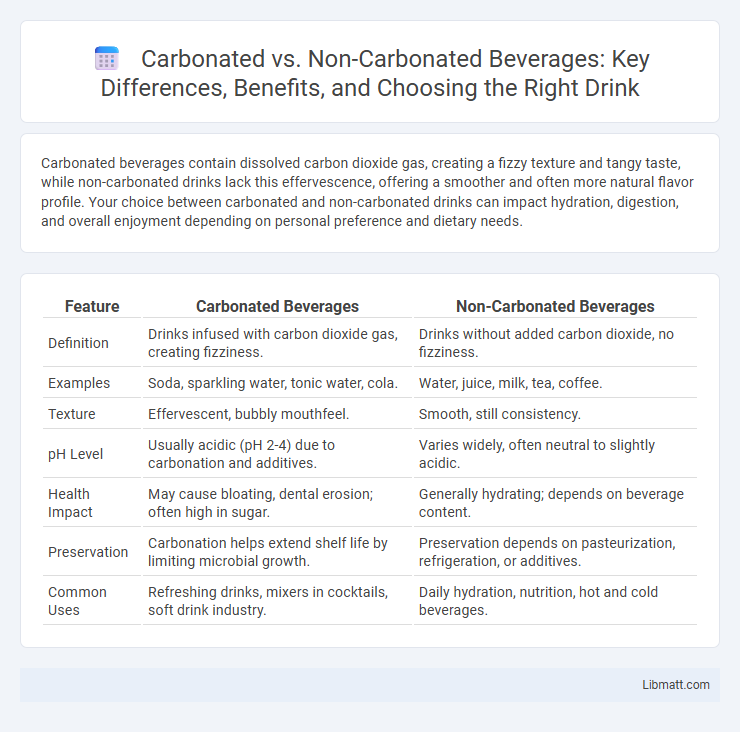Carbonated beverages contain dissolved carbon dioxide gas, creating a fizzy texture and tangy taste, while non-carbonated drinks lack this effervescence, offering a smoother and often more natural flavor profile. Your choice between carbonated and non-carbonated drinks can impact hydration, digestion, and overall enjoyment depending on personal preference and dietary needs.
Table of Comparison
| Feature | Carbonated Beverages | Non-Carbonated Beverages |
|---|---|---|
| Definition | Drinks infused with carbon dioxide gas, creating fizziness. | Drinks without added carbon dioxide, no fizziness. |
| Examples | Soda, sparkling water, tonic water, cola. | Water, juice, milk, tea, coffee. |
| Texture | Effervescent, bubbly mouthfeel. | Smooth, still consistency. |
| pH Level | Usually acidic (pH 2-4) due to carbonation and additives. | Varies widely, often neutral to slightly acidic. |
| Health Impact | May cause bloating, dental erosion; often high in sugar. | Generally hydrating; depends on beverage content. |
| Preservation | Carbonation helps extend shelf life by limiting microbial growth. | Preservation depends on pasteurization, refrigeration, or additives. |
| Common Uses | Refreshing drinks, mixers in cocktails, soft drink industry. | Daily hydration, nutrition, hot and cold beverages. |
Understanding Carbonated vs Non-Carbonated Beverages
Carbonated beverages contain dissolved carbon dioxide gas, creating bubbles and a fizzy texture, while non-carbonated beverages lack this effervescence, offering a smoother mouthfeel. Popular carbonated drinks include sodas, sparkling water, and tonic water, often enjoyed for their refreshing and tingling sensation. Non-carbonated beverages such as juices, teas, and still water provide hydration without the acidity or potential bloating associated with carbonation.
The Science Behind Carbonation
Carbonation occurs when carbon dioxide gas dissolves in a liquid under pressure, forming carbonic acid, which gives carbonated beverages their characteristic fizz and tangy taste. This process lowers the pH of the liquid, making it more acidic compared to non-carbonated drinks, which lack dissolved CO2 and maintain a neutral or slightly acidic pH. Understanding the science behind carbonation can help you choose beverages that best suit your taste preferences and digestive comfort.
Production Methods: Carbonated vs Non-Carbonated Drinks
Carbonated drinks undergo a production process where carbon dioxide gas is dissolved under high pressure, creating effervescence and a fizzy texture. Non-carbonated drinks are typically produced through simple mixing or extraction methods without gas infusion, resulting in a smoother, flat beverage. Understanding these production methods helps you choose between the sharp, bubbly sensation of carbonated drinks and the mild, natural taste of non-carbonated options.
Flavor Profiles: How Carbonation Affects Taste
Carbonation enhances flavor profiles by introducing a sharp, tangy sensation that stimulates the palate and accentuates sweet and sour notes. Non-carbonated beverages offer smoother, more straightforward taste experiences, allowing subtler flavors to come forward without the tingling bite of bubbles. The presence of carbon dioxide in carbonated drinks can also mask bitterness, making the overall flavor more balanced and refreshing.
Health Impacts of Carbonated and Non-Carbonated Drinks
Carbonated drinks often contain added sugars and acids that can contribute to tooth enamel erosion and digestive discomfort, while non-carbonated beverages like water and herbal teas generally support hydration and digestive health without these risks. You should be aware that excessive consumption of sugary carbonated sodas is linked to obesity, diabetes, and heart disease, whereas non-carbonated options tend to have fewer calories and no carbonation-related side effects. Choosing non-carbonated drinks can promote better overall health by reducing sugar intake and minimizing the potential for acid reflux and bloating.
Popular Examples of Each Beverage Type
Popular carbonated beverages include sodas like Coca-Cola, sparkling water brands such as LaCroix, and energy drinks like Red Bull, all characterized by their fizzy texture and effervescence. Non-carbonated drinks commonly consist of still water, fruit juices like orange juice, and iced teas, offering a smooth and refreshing hydration experience without bubbles. When choosing your beverage, consider whether you prefer the lively sensation of carbonation or the gentle taste of non-carbonated options.
Consumer Preferences and Market Trends
Consumer preferences for carbonated beverages often lean toward fizzy textures and bold flavors, driving strong market demand in soda and sparkling water categories. Non-carbonated drinks appeal to health-conscious consumers seeking smoother, natural options like juices and flavored waters, influencing growth in wellness-focused product lines. Your choice between carbonated and non-carbonated drinks will depend on taste preference, dietary needs, and current market trends highlighting convenience and health benefits.
Shelf Life and Storage Differences
Carbonated beverages have a longer shelf life due to the preservative effect of dissolved carbon dioxide, which inhibits microbial growth and oxidation compared to non-carbonated drinks. Non-carbonated beverages generally require refrigeration and airtight storage to prevent spoilage and maintain freshness, while carbonated drinks often remain stable at room temperature until opened. Proper storage conditions, such as cool temperatures and avoiding exposure to light, are essential for both types but more critical for non-carbonated products to extend their shelf life.
Environmental Implications of Beverage Choices
Carbonated beverages often require more energy-intensive production processes, including carbonation and packaging, which contribute to higher carbon footprints compared to non-carbonated drinks. Your choice of non-carbonated beverages can reduce environmental impact due to simpler manufacturing and lower resource consumption. Opting for sustainably packaged and locally produced non-carbonated options further minimizes environmental harm.
Making the Right Choice: Which Is Best for You?
Choosing between carbonated and non-carbonated beverages depends on your lifestyle and health preferences. Carbonated drinks offer a refreshing, fizzy sensation ideal for social occasions, but non-carbonated options are often better for hydration and digestive comfort. Understanding your body's response and nutritional goals helps ensure you make the best choice to support your well-being.
Carbonated vs non-carbonated Infographic

 libmatt.com
libmatt.com